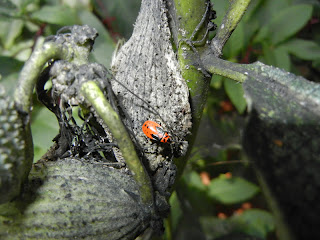I hate to admit it, but nature study is one of the first things to get dropped off the to-do list when our lives get busy or when other "more important" subjects need to be completed.
In order not to fall off the nature study wagon the first month back to school, I needed to keep it simple. I have a tendency to go overboard. With nature study, that means too much "study" and not enough "nature". This is where the resources that Barb has provided have saved me from myself.
What did we do this month?
- We used Barb's insect study grid and insect list (from the September newsletter) to give a focus to our nature study.
- We used the Insect Study notebook page to research a few specific insects that interested us.
- We used the small square study as another activity to get us outdoors.
We started a few weeks ago by going on a bug hunt in an overgrown area at the end of the street. B and I both had our digital cameras and I told him to just see what he could find. We found quite a few wasps and bees on the goldenrod. Those were a little tricky to get pictures of because they kept moving.
We also found a couple of insects on the milkweed. We didn't know what they were, but with the cameras, we could take pictures to use for reference later. A few days later, I gave B the Insect Study notebook page created by Barb and had him see if he could identify what we had found. He used a field guide and the internet to determine that our insect was a Small Milkweed Bug. One of the interesting things we found was that another insect we found on the milkweed - and thought was something altogether different - was the nymph of the Small Milkweed Bug.
 |
| Small Milkweed Bug adult. |
 |
| Small Milkweed Bug nymph. |
This week, I sent him out into the yard with some string and had him choose a place for his Small Square Study. The place he chose was an old stump. We found plenty of things to put in our living or once-living category, but the non-living category was harder. As we sat there, I noticed some ants coming down the hemlock tree next to me. We managed to get two of them into the bug magnifier and bring them inside for closer inspection. We have tentatively identified them as red-banded carpenter ants. (Back out to the tree and away from the house they went).
 |
| Red-banded carpenter ants (we think). |
The only other type of ant we have seen this month is a citronella ant. Actually, it wasn't just one ant, but a seething swarm of them. They were in our back yard and I kind of freaked out because I thought they were termites. The vast majority of the ants (hundreds and hundreds) had wings and covered an area of about one square foot. They had obviously come up out of a hole in the ground. Interspersed with these flying ants was an occasional light colored ant (the reason I thought they were termites). I called a local pest control company and when I described what was happening, I was told they were citronella ants. Termites swarm in the spring.
With my mind relieved and my curiosity piqued, we looked up some information on citronella ants. First, we found that they get their name from an odor they give off that is especially noticeable if they are crushed. Also, it seems they "farm" aphids for their honeydew.
After adding all of our insects to our insect list and checking off the boxes on our insect study grid, we took a few minutes to go through the Powerpoint slide presentation on insects that I found at the East Tennessee Wildflowers website. Here we reviewed information on the difference between insects and spiders, complete versus incomplete metamorphosis, and other insect facts. What we found interesting or important to remember, we added to our nature notebook.
It felt so good to get some nature study in this month and it wasn't that hard! We're looking forward to more nature study in the months ahead.

I can't tell you how wonderful it is to hear how your month of study using the Insect Grid and other printables from the HNS has gone. This is exactly what I wanted families to do and I love seeing the results.
ReplyDeletePerfect!
Great job at identifying your insects too because sometimes that is the hardest part of nature study. Loved seeing your images too.
Thank for sharing your nature study with the OHC.
very neat. I need to remember this. Nature study can be simple. I should make it so.
ReplyDeleteI love that you saw the small milkweed bug and its nymph. I have read about it, but only recently identified what a milkweed plant actually looks like, so I haven't seen one in person yet. It is definitely on my bucket list of "insects I want to see."
ReplyDeleteOur family loves milkweed plants! We've seen lots of milk weed bugs, but never their nymph. Very cool!
ReplyDeleteI agree about the keep it simple approach.I liked your close up photo of the bee/wasp.
ReplyDeleteFortunately the insect study was in September. The milkweed plants have been permanently removed by the town. To be fair, the cul-de-sac was rather unsightly. They cut down the large pine that was there and dug all the weeds/wildflowers up. Looks like they are planning to pave the whole thing. The bonus for the town is that plowing will be easier. The bonus for my boys is that they have gained a great street hockey area.
ReplyDeleteI'm still sad for my milkweed plants, though.